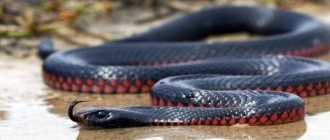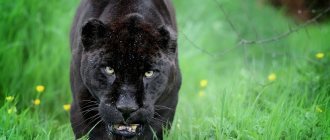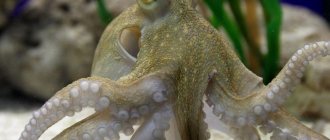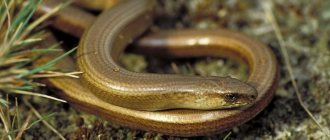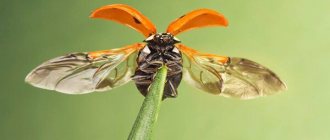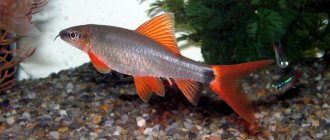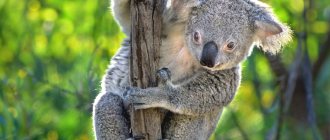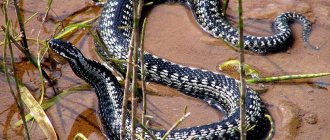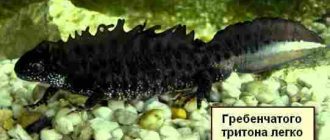The brittle spindle (or slow spindle) is probably familiar to everyone. Some know it as a kind of lizard without legs, others - “as a dangerous copperhead snake.” The roots of this pseudo-legend about the mortal danger of the spindle are still unknown. Perhaps the legend stems from confusion between the red viper and the harmless lizard.
The fusiforms (Anguidae) include modern legless lizards that look like snakes, as well as species with a shortened body and fully developed limbs. The family includes 80 species. They live in Europe, Asia, America and Africa. On the territory of Russia there are 2 representatives of this family - the yellow-bellied and, in fact, the brittle spindle, which will be discussed in this article.
What does a brittle spindle look like?
The brittle spindle (Anguis fragilis) is a peculiar species of legless lizard. It has a long (up to 40 cm) spindle-shaped body. The head is almost not separated from the body by the neck, the tail is blunt, brittle, like that of lizards. The eyes are relatively small, the ear openings are small but well developed.
The color of the spindles is variable. Juveniles are a beautiful light cream color on top with two closely spaced thin dark stripes running along the ridge, starting from a triangular spot located on the back of the head. The sides are black-brown in color, and the lower surface of the body is black. As lizards grow older, the color of the back darkens, acquiring brown, brown or bronze tones, while the sides become lighter.
The difference in the color of males and females is that the former have a dark brown upper body, often with blue spots, while the females have a gray-brown upper body and a darker lower body.
These lizards are often mistaken for snakes, particularly poisonous ones, which is why they have a bad reputation. The spindle can be distinguished from a snake, firstly, by the presence of a brittle tail, and secondly, by its eyes with movable eyelids (all snakes have eyes that do not blink due to fixed eyelids).
Spreading
Brittle spindle is widely represented in central and southern Europe, the Caucasus, and northern Iran. In the territory of the former Soviet Union, it is found in forests from the Baltic, Belarus, Ukraine and Moldova to the valley on the left bank of the Tobol River (Western Siberia). In addition, it lives in the forests of Transcaucasia and the countries of the North Caucasus.
In some regions, the brittle spindle is considered an endangered species. The Red Books of Tatarstan, Bashkortostan, the Komi Republic, Kostroma, Vologda, Moscow, Smolensk, Sverdlovsk, Tver, Chelyabinsk and Tyumen regions have been replenished with this species in recent years.
Brittle spindle (sweetheart is the second name) prefers to settle in mixed and broad-leaved forests, at the borders of forests on the outskirts of meadows and fields, in clearings, forest clearings and in gardens. In the Caucasus, it settles in mountain forests, on slopes overgrown with bushes. The lizard usually hides in the forest floor, under stones, fallen trees, in rotten stumps, in burrows of burrowing animals, and in dead wood.
Brittle spindle: what is its other name, what is the difference from copperhead, copperhead?
The reptile is often called the copperhead because of its color, which has a bronze or copper tint. This is what leads to confusion, because there is a separate species of snake called the copperhead. Many people confuse the copperhead with the copperhead, although they are actually two different subspecies. Because the copperhead is a snake, and the copperhead is a lizard.
Of course, it is quite difficult for an ordinary person who has nothing to do with animals to distinguish between a copperhead and a copperhead; in appearance they are really similar. But there are still a few differences:
Differences:
- The copperhead belongs to the colubrid snakes. It is distinguished by a bronze body, has an average length of 70 cm. The body is covered with scales, the pupil is round, and has no eyelids. Very mobile, flexible, tail quite elongated.
- The spindle, that is, the spindle, is a little shorter. Its length is approximately 50 cm. The shape of the head is different, it is almost fused with the body, and only towards the end it becomes sharp.
- The copperhead has a more pronounced head, although the cervical region is also poorly visible. Reptiles also differ in color. The copperhead is darker, the copperhead is somewhat lighter.
- The copperhead's eyes are different; they are round, quite large and do not close. The copperhead, that is, the lizard, has a movable eyelid, like all lizards.
Spindle
copperhead
Lifestyle and habitat
Spindles lead a sedentary lifestyle and rarely change their “place of residence.” At the same time, their habitat is incredibly vast. The species is found everywhere, regardless of climatic conditions. You can see spindles both in the hottest Asian countries and on the lower northern continent.
Lizards move quite slowly, both in water and on land. The reason for this is the same scaly cover, characterized not only by strength, but also by impressive weight. Habitat – old stumps, forest litter, loose soil, etc.
It is quite difficult to meet a lizard in natural conditions. But it is very interesting to watch her. Some eyewitnesses claim that the spindle lives even under a pile of accumulated garbage or in rags and is not at all afraid of people. It is easily tamed and can become a real pet, taking food from your hands.
In spring, the legless spindle is active during the daytime. Closer to summer - activity is observed with the onset of darkness. The reptile hunts using a highly sensitive sense of smell, due to poor eyesight and slowness. That is why the radius of its movement is small and limited to a few meters.
Lizards, unlike their relatives, hibernate at temperatures below 10°C. They are pre-prepared for a long sleep. They gather in small groups of up to 30 individuals and dig labyrinthine depressions up to 70 cm long. In rare cases, spindles may share their wintering place with other reptiles or vipers.
The slowness of lizards makes them easy prey for birds and animals. Therefore, they prefer to hide, sometimes even hiding in anthills. The same skin protects them from bites. Slowness, calmness and friendliness - this is what characterizes the way of life of spindles.
However, in dangerous situations they can take on a rather terrifying appearance - stick out their forked tongue and hiss like a snake. If this does not stop the enemy, they try to quickly run away.
It is very difficult for lizards to move in open areas. But when making their way through obstacles - between trees, bushes, etc., they demonstrate high speed and agility, but quickly get tired and try to find shelter.
The spindle reptile , however, only at first glance, has an external resemblance to a snake. The lizard's movement is completely different. It wriggles like a snake, wave-like, while creating the impression of vain hesitation.
The same protective shell does not give the reptile the necessary “amplitude” of the wave. She has to squirm more actively, which leads to rapid fatigue and slowness. At the same time, she is not afraid of damage from sharp branches, thorns and other dangers encountered along the way.
Spindles lead a hidden lifestyle, preferring to be active at night.
Feeding spindles
The brittle spindle is a predatory animal. Because of their slowness, they hunt mainly even more clumsy animals. The main food of spindles is insects, earthworms, slugs, insect larvae, and snails.
The vision of these lizards is extremely poorly developed. The main organ for orientation in space and searching for prey is the tongue. The copperhead first carefully examines the victim with a sensitive tongue, and then swallows it whole.
The lizard uses sharp teeth to hold prey. The brittle spindle gradually pulls the earthworm out of the ground entirely or unscrews the already pulled out part if it is not possible to pull out all the prey. Similarly, the spindle takes snails out of shells.
Interesting facts about the animal
Amazing facts about brittle spindle:
- half the length is on the tail;
- the bony shell interferes with rapid movement, but protects from stones and bushes;
- vision is monochrome in gray;
- a human-tamed copperhead does not bite, but for the purpose of protection it is capable of inflicting deep, painful bites;
To protect itself when attacked, the lizard not only throws off its tail, but also turns over with its black belly up and “shoots” its excrement at the enemy.
Keeping at home
The common spindle is a fairly popular pet among reptile lovers. Given comfortable conditions and proper care, this lizard can live at home much longer than its natural life expectancy. There are cases where spindles in captivity have lived up to 30 years.
For maintenance, you need a spacious terrarium with shelters, plants and a shallow pond. Warming up the terrarium to temperatures that are comfortable for the pet should be provided with special lamps and thermal mats. Daytime temperatures should be around 30 C in a warm corner. Be sure to irradiate the terrarium with a UV lamp. In sunny, warm weather in the summer, you can take the spindle outside in a container with shelter.
It is important to maintain a certain level of humidity by spraying the terrarium and moistening the soil.
They feed the copperhead:
6 payments that pensioners are no longer required to pay for
The program comes into force in Volgograd! If sugar is above 4.8 mmol/l, he is entitled to...
- worms (earthworms, mealworms);
- larvae;
- insects (crickets, cockroaches);
- spiders;
- shellfish (slugs, snails) and other live food.
The feeding schedule of an adult is approximately once every 3 days. Young animals are fed more often. As food additives, it is important to use mineral supplements containing calcium and other trace elements. Brittle spindles reproduce well in captivity. When the appropriate conditions are created, the female brings an average of 10 cubs (from 2 to 25) in the spring and summer.
Reproduction of brittle spindles
Little is known about the social and mating behavior of spindles, since all their contacts take place in shelters. During the mating season, males become aggressive and fierce fights occur between them. Their main weapons are teeth (since there are no limbs). Marriage partners find each other, apparently, by smell. They mate in the spring, with the male holding the female by the neck with his jaws.
The female bears the offspring for about three months. In mid-summer and early autumn, she gives birth to cubs in transparent egg shells. In nature, this happens somewhere in a secluded place. In a litter there are from 5 to 26 cubs, which immediately after birth begin to move, break the shells and crawl away. There have been cases of females eating newborns. Young spindles feed on small soil animals.
Not earlier than in the third year of life, having reached a length of about 25 centimeters, they become sexually mature.
Protection from enemies
These animals are protected by a hidden lifestyle, as well as by bone chain mail located under the scales. In addition, they can throw off their tail and also “shoot” excrement. Unusual defensive behavior is observed in young individuals. In case of danger, young copperheads roll over onto their backs, showing their dark belly. Apparently, such a change in color produces the effect of surprise.
However, this arsenal is not enough, so the spindle often becomes a victim of various predators. Both ground beetles (predatory beetles), and various snakes, and toads eat young lizards. Martens, foxes, hedgehogs, badgers, night and day birds (there are more than 25 species of birds that feed on copperheads) - this is not a complete list of enemies of the species of interest to us. It is curious that among the snakes, the copperhead is especially often swallowed by the copperhead. People also destroy these lizards very often. In different countries there is a strange superstition about their “terrible poisonousness,” although in fact the spindles are absolutely harmless.
Wintering
Brittle spindles overwinter in deep passages or burrows. Sometimes their depth reaches seventy centimeters. It is not easy for these lizards to find places suitable for wintering, so several individuals gather in burrows at once, often the number of “residents” exceeds 30 individuals. The entrance to its winter lair is usually covered with earth, moss or grass. Interestingly, some spindles spend the winter in the company of vipers and amphibians.
The spindle, like almost all scaly reptiles, molts periodically. However, they do not shed their old skin entirely like snakes, but move the dead cells closer to the tail, and then shed it in rings.
First aid for a copperhead bite
- The wound should be washed with running and clean water. As a last resort, you can at least use antiseptic wipes.
- Be sure to treat the wound with an alcohol-based antiseptic. This must be done within half an hour to prevent the spread of infection or the development of “bad” germs and bacteria.
- A cold compress should be applied to the bite site. You can simply use a bottle of cold water or a napkin soaked in cool liquid.
- Do not drink alcohol under any circumstances to neutralize the poison! This is a myth and just complete nonsense. Under the influence of alcohol, the blood thins, and the poison is only transferred faster.
copperhead
- If available, the patient should be given an anesthetic. Allergy sufferers should definitely take an antihistamine.
- The patient should take a horizontal position, relax and rest a little. You also need to provide the victim with plenty of warm fluids!
- If the condition worsens or if severe allergic reactions occur, the patient is taken to the hospital!
Differences from snakes
When people encounter a legless lizard, they most often mistake it for a poisonous snake and try to kill the animal. Of course, reptiles have similarities: both legless lizards and snakes move by wriggling their bodies. However, if you look closely, you can find several pronounced differences between the two types of reptiles. Let's look at the difference using the example of two lizards: the spindle and the yellow-bellied lizard.
Firstly, they have movable eyelids, while in snakes they are fused, thereby forming a transparent protective layer over the eyes. Lizards have an ear opening, which is located behind the organs of vision. Snakes do not have it.
Secondly, the head and body are fastened differently in reptiles. If the spindle and the yellow-bellied do not have any narrowings in the neck area, then in snakes they are clearly pronounced.
What is the difference between a legless lizard and a snake? In lizards, the left and right parts of the jaws are connected more rigidly, in addition, these animals have a shoulder girdle.
